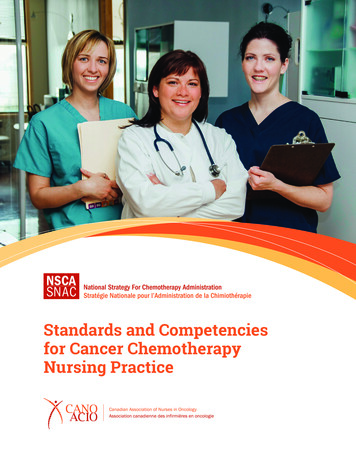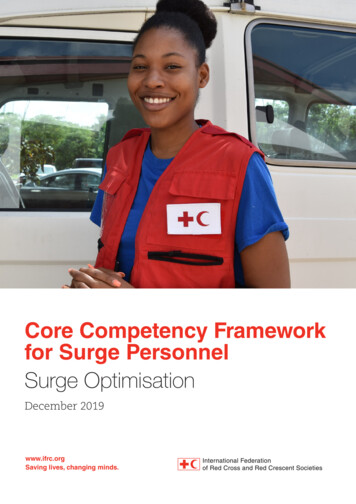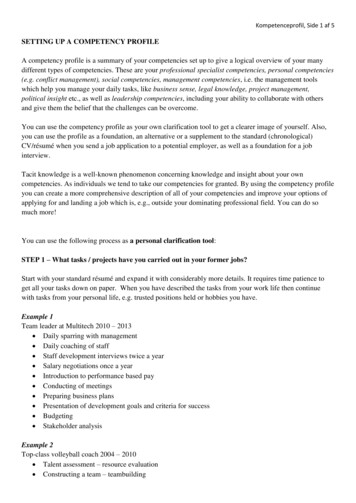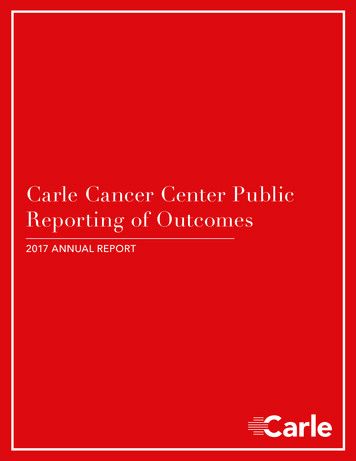
Transcription
Standards and Competenciesfor Cancer ChemotherapyNursing Practice
CANO/ACIO STANDARDS & COMPETENCIES FOR CANCER CHEMOTHERAPY NURSINGSEPTEMBER 2017ACKNOWLEDGEMENTDISCLAIMERCANO/ACIO would like to acknowledge the Standardsand Competencies for Cancer Chemotherapy NursingPractice volunteer development team for theiroutstanding dedication and commitment to thisinitiative and for all of their hardwork over the past twoyears. The following volunteers were essential in thedevelopment of this document and helped bring theNational Strategy for Chemotherapy Administrationvision to life. Our sincerest gratitude to Kristian Burns,Renee Hartzell, Barb Hues, Inara Karrei, Vicki Lejambe,Laura Mercer, Judy Oliver, Karyn Perry, Agnes Piotrowski,Laura Rashleigh, Brenda Ross, Pamela Savage, and TracyTruant.These CANO/ACIO Standards and Competencies forCancer Chemotherapy Nursing Practice are intendedfor use by trained Registered Nurses (RNs). Theyprovide general guidance on appropriate practice andtheir use is subject to the registered nurses’ judgmentin each individual case. The CANO/ACIO Standardsand Competencies for Cancer Chemotherapy NursingPractice are designed to provide information to assistdecision-making and are not meant to be prescriptive.Individuals who use this statement are required tomake their own determination regarding specific safeand appropriate clinical practices. While care has beentaken to ensure that this statement reflects the state ofgeneral knowledge and expert consensus about practicein the field at the date of publication, CANO/ACIO doesnot make any warranty or guarantee in respect to any ofthe contents or information contained in this statementnor accept responsibility or liability whatsoever forany errors or omissions in the statement, regardlessof whether those errors or omissions were madenegligently or otherwise.CANO/ACIO would also like to acknowledge the followingstakeholders for their participation during the consensusbuilding process of this document; AccreditationCanada, Canadian Nurses Association, PediatricOncology Group of Ontario, BC Children’s Hospital andthe Canadian Association of Provincial Cancer Agencies. Standards and Competencies for Cancer Chemotherapy Nursing Practice2
SEPTEMBER 2017CANO/ACIO STANDARDS & COMPETENCIES FOR CANCER CHEMOTHERAPY NURSINGTABLE OF CONTENTSIntroduction .4Purpose and Scope . 4Development Process . 4Source Documents . . . 5Working Groups Involved in the Development of the Standards and Competencies . . . 5The Canadian Context for Cancer Chemotherapy in theTreatment of Adult and Pediatric Persons with Cancer .6Complexity of Cancer Chemotherapy Treatment . 6Risks of Cancer Chemotherapy Drugs . . . 6Shifting Models for Cancer Chemotherapy Care . . . 7The Role of the Person Receiving Cancer Chemotherapy . . . 7Variable Access to Chemotherapy Resources and Expertise . . . 7Diverse Roles of Canadian Registered Nurses inCancer Chemotherapy Care . 8CANO/ACIO Cancer Chemotherapy Nursing PracticeStandards and Competencies .8Standard A: Accountability for Cancer Chemotherapy NursingPractice in Canada by Registered Nurses . . 10Standard B: Quality Practice Environments for Optimal CancerChemotherapy Nursing Practice . 14Standard C: Education Requirements for Developing Competencein Cancer Chemotherapy . 17Standard D: Cancer Chemotherapy ContinuingCompetence Program . 19References . 21Bibliography . 23Appendix A: Definitions . . . 26Appendix B: National Strategy for Chemotherapy AdministrationStandards and Competency Volunteer Working Group . . . 283
CANO/ACIO STANDARDS & COMPETENCIES FOR CANCER CHEMOTHERAPY NURSINGSEPTEMBER 2017CANO/ACIO STANDARDS AND COMPETENCIES FORCANCER CHEMOTHERAPY NURSING PRACTICEINTRODUCTIONPurpose and ScopeThis document has been written to provide standards for the practice, education, and continuing competence of RegisteredNurses (RNs) and for the quality practice environment required to ensure optimal cancer chemotherapy nursing practice inCanada. Cancer Chemotherapy refers to the wide range of therapeutic options used in the treatment of malignant diseases,including categories such as cytotoxic drugs, biologics, immunotherapies, targeted drug therapies, hormonal treatments,and high dose chemotherapy regimens supported with hematopoietic stem cell transplant1. The use of the term person orpersons will represent both persons living with cancer and their families, unless otherwise specified.This document applies to the practice of Registered Nurses who provide cancer chemotherapy care for adult andpediatric patients in diverse settings throughout Canada where English and French languages are spoken, such as urbanand rural, acute and community and inpatient and ambulatory clinics.These Standards and Competencies have been written to provide general direction to nurses caring for persons receivingcancer chemotherapy to:1. Determine their roles relevant to the Standards and Competencies.2. Develop measures that reflect the outcomes of standards2.3. Establish criteria for education programs that develop cancer chemotherapy nursing competencies.4. Establish criteria for continuing competence programs to maintain competence.5. Provide a foundation for recommendations to the interdisciplinary team for the qualitypractice environments required for optimal cancer chemotherapy practice.12Canadian Association of Pharmacists in Oncology (CAPhO). (2004). Standards of Practice for Oncology Pharmacy in Canada, (1) 49. North Vancouver, British Columbia: AuthorCanadian Association of Nurses in Oncology/Association Canadienne des Infirmieres en Oncologie (CANO\ACIO). (n.d.). Rationale for Standards of Care. Retrieved August 20, 2010from www.cano-acio.ca.3CANO/ACIO. (September 2008). Developing a National Strategy for Chemotherapy Administration, p.1. Vancouver, British Columbia, Canada: Author.4CANO/ACIO. (2009). National Strategy for Chemotherapy Administration Phase I Final Report, p.6. Vancouver, British Columbia, Canada: Author.4
SEPTEMBER 2017CANO/ACIO STANDARDS & COMPETENCIES FOR CANCER CHEMOTHERAPY NURSINGDevelopment ProcessThe National Strategy for Chemotherapy Administration (NSCA) is a three-phased special initiative of CANO/ACIOthat seeks to establish national chemotherapy administration standards, competencies and educational resourcesfor oncology nurses across Canada 3. In Phase One, a Canadian and international chemotherapy nursing practiceenvironmental scan was carried out using a literature search, snowball survey, and focus groups 4. Formative criteriafor standards and competencies were drawn from the findings of the literature and the environmental scan. Draftchemotherapy nursing practice standards and competencies that reflect the diverse care settings where personsreceive chemotherapy care were developed based on the above-mentioned formative criteria. At a meeting ofoncology nursing experts at the 2009 annual CANO/ACIO conference, the need for a unique Canadian statement ofstandards was further validated 5.Phase Two built upon the foundational work of Phase One, implementing a consensus building approach. Phase Oneprovided the foundational objectives and values, summarized CANO/ACIO member needs and concerns regarding cancerchemotherapy, and summarized the extant literature, providing the context and evidence required for the consensusmethodology. During Phase Two, an expert volunteer working group was convened, with representation from multipleprovinces in Canada to refine and revise the initial draft standards developed in Phase One. Criteria were developed,modeled from the ASCO/ONS6 process, to guide the review of the standards and competencies. Surveys and votingstrategies were implemented, to enable feedback on the standards and criteria from all members across broad distances.Consensus was considered one hundred percent agreement of working group members present at the teleconferenceand web-based meetings. Multiple revisions were developed through small group work to reach a reformulated secondversion. Further consensus, as guided by the foundational criteria, was sought from the membership of CANO/ACIO, andfrom national and international stakeholders. The expert working group collated and incorporated the membershipand stakeholder feedback in the final standards and competence document. The Third Phase, which is underway, is theimplementation and evaluation of the standards and competencies.Source DocumentsThe CANO/ACIO Standards and Competencies for Cancer Chemotherapy Nursing Practice were derived from a synthesis ofthe reviewed literature, an environmental scan of Canadian and international chemotherapy nursing practice and expertconsensus. The results of the literature review and the environmental scan are available in the following documents:1. CANO/ACIO National Chemotherapy Administration Nursing Practice Strategy Phase I Final Report, April 6, 2009.2. CANO/ACIO Readying Phase II Synthesis of Findings from International Environmental Scan, November 16, 2009.The reference list and bibliography for the CANO/ACIO Standards and Competencies for Cancer Chemotherapy NursingPractice list the key documents that informed this body of work.5CANO/ACIO. (2009). Final Report Readying for Phase II: Preparing for an Invitational National Strategy for Chemotherapy Administration Workshop, p.5. Vancouver, BritishColumbia, Canada: Author.6Jacobson, J. O., Polovich, M. McNiff, K. K., LeFebvre, K. B., Cummings, C., Galioto, M., Bonelli, K. R., & McCorkle, M. R. (2009). American Society of Clinical Oncology/OncologyNursing Society Chemotherapy Administration Safety Standards. Journal of Clinical Oncology , 27, 5469-5475.5
CANO/ACIO STANDARDS & COMPETENCIES FOR CANCER CHEMOTHERAPY NURSINGSEPTEMBER 2017Working Groups Involved in the Development of the Standardsand CompetenciesCANO/ACIO gratefully acknowledges the efforts of the following groups of nurse members who contributed to theenvisioning and the development of the CANO/ACIO National Standards and Competencies for Chemotherapy NursingPractice.1. CANO/ACIO Think Tank (2007)2. CANO/ACIO Round Table Workshop: Chemotherapy Safety (2008)3. CANO/ACIO National Strategy for Chemotherapy Administration (NSCA) Invitational Workshop (2009)4. CANO/ACIO NSCA Standards and Competencies Working Group (2010 and 2011)5. CANO/ACIO NSCA Evaluation Working Group (2010 and 2011)6. CANO/ACIO NSCA Invitational Workshop (2010)7. Members and stakeholders involved in the consensus process (2010 and 2011)THE CANADIAN CONTEXT FOR CANCERCHEMOTHERAPY IN THE TREATMENT OF ADULT ANDPEDIATRIC PATIENTS WITH CANCERThe following summary highlights key factors that impact the nursing care of persons receiving cancer chemotherapycare in Canada.Complexity of Cancer Chemotherapy TreatmentChemotherapy drugs are primarily used for the treatment of cancer. Recently, the use of cancer chemotherapy forcancer treatment has increased significantly, stimulated by new knowledge about cancer biology, innovative methods oftargeting biotherapy to specific cancer cell characteristics, and the increased use of cancer chemotherapy or biotherapyas an adjuvant to surgery and radiation treatment. Treatment regimens are complex, often delivered cyclically overextended periods by a variety of routes, and may involve the use of mechanical or vascular access devices.Risks of Cancer Chemotherapy Drugs7“There are many stressors and acute and chronic adverse effects that persons receiving cancer chemotherapy mayexperience that require specialized nursing care and supportive interventions.”8 Many cancer chemotherapy drugsare highly toxic to cells. Exposure to cytotoxic cancer chemotherapy drugs and their waste during preparation,administration, and disposal is an occupational hazard for health care workers, as these drugs are known to bemutagenic, carcinogenic and teratogenic9. Additionally, persons receiving chemotherapy and their family members canalso be exposed to the hazards of chemotherapy drugs when they handle contaminated equipment or body fluids. Theincreasing complexity in cancer chemotherapy protocols inherently increases risks.7Cancer Nurses Society of Australia (CNSA). (2003). Position Statement on the Minimum Education and Safety Requirements for RNs Involved in the Administration of CytotoxicDrugs, p.1. Retrieved March 2009, from osition-Statement-33b-1.pdf.aspx8CNSA. (2003). Position Statement on the Minimum Education and Safety Requirements for RNs Involved in the Administration of Cytotoxic Drugs, p.1. Retrieved March 2009,from http://www.cnsa.org.au/publications policies pub.htm9CNSA. (2003). Position Statement on the Minimum Education and Safety Requirements for RNs Involved in the Administration of Cytotoxic Drugs, p.1. Retrieved March 2009,from http://www.cnsa.org.au/publications policies pub.htm6
SEPTEMBER 2017CANO/ACIO STANDARDS & COMPETENCIES FOR CANCER CHEMOTHERAPY NURSINGShifting Models for Cancer Chemotherapy Care10In the past, people have received cancer chemotherapy in specialized hospitals or treatment centers. Smaller centersand clinics in metropolitan, rural and remote communities are now able to provide chemotherapy services becauseof improvements in side effect management, demands for cost containment, advances in technology, an emphasis onconsumer choice, and a desire to provide cancer care and treatment closer to home11. In addition, many persons arereceiving cancer chemotherapy in their homes12. Nurses working in different jurisdictions are involved in the treatmentand supportive care of the person and family, as persons move through multiple settings to receive their chemotherapycare. Health care practitioners must communicate and collaborate across systems and organizations to createchemotherapy treatment plans, carry out comprehensive health care assessments, and provide the necessary educationand psychosocial support to facilitate self-care, administration and monitoring. This education includes preparingpersons, to evaluate and respond to side effects and adverse events. Continuity of care is essential for patient safety,and yet challenging to ensure; transfers of care between settings require communication and collaboration, sharedunderstanding of clinical management, and access to resources.The Role of the Person Receiving Cancer Chemotherapy andFamilyThe patient receiving cancer chemotherapy and their family must understand the self-care required (or care supportedby the family) during treatment and know how to access resources to handle problems or concerns safely. In thecase of the pediatric patient, the parent and/or caregiver should know how to access resources to handle problems orconcerns safely. Frequently the period for greatest potential toxicity from cancer chemotherapy occurs when the personis at home. The family and significant others help to provide support to the person receiving treatment and requireknowledge and skill to carry out that role. Effective education and preparation is essential.Variable Access to Cancer Chemotherapy Resources andExpertiseIn Canada, groups of cancer experts advocate for oncology practice and advise the federal government about the needfor changes in cancer care. Advances in chemotherapy practice and the development of expertise in evidence-basedchemotherapy care, may not be translated to providers at the local, regional or provincial levels. Registered Nursesthroughout Canada work in diverse and sometimes, disconnected clinical settings, teams, and jurisdictions to providecancer chemotherapy care. These nurses have variable access to the guidelines, standards, education and continuingcompetence programs, and the chemotherapy expertise required for optimal practice14.10CNSA. (2003). Position Statement on the Minimum Education and Safety Requirements for RNs Involved in the Administration of Cytotoxic Drugs, p.1. Retrieved March 2009,from http://www.cnsa.org.au/publications policies pub.htm11CNSA. (2003). Position Statement on the Minimum Education and Safety Requirements for RNs Involved in the Administration of Cytotoxic Drugs, p.15. Retrieved March 2009,from http://www.cnsa.org.au/publications policies pub.htm12CANO/ACIO. (2009). National Chemotherapy Administration Nursing Practice Strategy Phase I Final Report, p. 15. Vancouver, British Columbia, Canada: Author.1314National Cancer Institute Cancer Therapy Evaluation Program. (1999). Common Toxicity Criteria Quick Reference. Common Toxicity Criteria Manual Version 2.0, p.3.CANO/ACIO. (2009). National Chemotherapy Administration Nursing Practice Strategy Phase I Final Report, p.24.Vancouver, British Columbia, Canada: Author.7
CANO/ACIO STANDARDS & COMPETENCIES FOR CANCER CHEMOTHERAPY NURSINGSEPTEMBER 2017Diverse Roles of Canadian Registered Nurses in CancerChemotherapy CareRegistered Nurses in different agencies and clinical settings have diverse roles in ensuring safe and competent cancerchemotherapy care15 such as nurses who: Assess capacity for self-care.Provide cancer chemotherapy education, including explaining the chemotherapy plan of care.Identify, organize and ensure provision of resources and supports for management of self-care.Administer chemotherapy in a variety of settings including clinics, inpatient units, and home environments.Provide telephone support for the management of symptoms related to cancer and cancer treatment including themanagement of mechanical devices used to deliver ambulatory infusions. Advocate for the supports required to ensure a quality practice environment and on-going competence. Research aspects of chemotherapy care including symptom management and models of care delivery, andfacilitate dissemination and uptake of evidence-based knowledge into clinical practice. Adapt and interpret standards for the practice environment and care providers.CANO/ACIO CANCER CHEMOTHERAPY NURSINGPRACTICE STANDARDS AND COMPETENCIESStandards for cancer chemotherapy nursing practice have been written to reflect both the CANO standards of practiceand chemotherapy best practice16. The standards articulate what Registered Nurses are expected to do to demonstratecancer chemotherapy competence and are underpinned by the CANO/ACIO Position Statement for Cancer ChemotherapyNursing Practice17. The literature and Canadian focus groups identified the four areas for Canadian cancer chemotherapynursing standard development, which are as follows:A. Accountability for Cancer Chemotherapy Nursing Practice and Care in Canada by Registered Nurses.B. Quality Practice Environment for Optimal Cancer Chemotherapy Nursing Practice.C. Educational Requirements for Developing Competence in Cancer Chemotherapy.D. Cancer Chemotherapy Continuing Competence Program.1516178CANO/ACIO. (2009). National Chemotherapy Administration Nursing Practice Strategy Phase I Final Report, p.47. Vancouver, British Columbia, Canada: Author.CANO/ACIO. (2006). Practice Standards and Competencies for the Specialized Oncology Nurse. Vancouver, British Columbia, Canada: AuthorCANO/ACIO (2010). Position Statement for Cancer Chemotherapy Nursing Practice. Vancouver, British Colombia, Canada: Author
SEPTEMBER 2017CANO/ACIO STANDARDS & COMPETENCIES FOR CANCER CHEMOTHERAPY NURSINGThe first standard, Accountability for Cancer Chemotherapy Nursing Practice and Care in Canada by RegisteredNurses, describes the overarching expectations for cancer chemotherapy nursing practice in Canada. Registered Nursecompetencies are detailed within this standard and reflect best chemotherapy nursing practice based on a review ofevidence and expert consensus. The CANO/ACIO Practice Standards and Competencies for the Specialized OncologyNurse provided the conceptual framework for the articulated competencies18. The articulated competencies providegeneralist, specialist and advanced Registered Nurses, educators, and administrators with descriptors of competentcancer chemotherapy nursing practice. In addition, these competencies can form the basis for the development ofmeasurement tools for assessing and monitoring cancer chemotherapy nursing practice.The remaining three standards in the document are foundational for optimal cancer chemotherapy nursing practice.These standards do not include corresponding competencies, as the competencies for cancer chemotherapy nursingpractice are described in standard A.Standard B, Quality Practice Environment for Optimal Cancer Chemotherapy Nursing Practice, details the organizationalsystems, policies and procedures, and continuity of care required for optimal cancer chemotherapy nursing practice.Standard C, Educational Requirements for Developing Competence in Cancer Chemotherapy, defines the educationalprogram requirements for nurses to develop competence, including evaluation criteria. The final standard, CancerChemotherapy Continuing Competence Program, articulates the requirements for an annual continuing competencyprogram for Registered Nurses, including methods for identifying learning needs and strategies to meet learning goals.18CANO/ACIO. (2006). Practice Standards and Competencies for the Specialized Oncology Nurse. Vancouver, British Columbia, Canada: Author9
CANO/ACIO STANDARDS & COMPETENCIES FOR CANCER CHEMOTHERAPY NURSINGSEPTEMBER 2017STANDARD A.Accountability for Cancer Chemotherapy NursingPractice and Care in Canada by Registered NursesCANO/ACIO POSITION STATEMENT #2:Cancer chemotherapy should be delivered by Registered Nurses and patients receiving chemotherapy forthe treatment of cancer should receive care from Registered Nurses.Patients receiving chemotherapy have unpredictable outcomes. Complex patients with unpredictable outcomesfall under the domain of Registered Nurses (College of Nurses of Ontario, 2009, p.1). In addition to the natureof the patient and of chemotherapy care, many oncology nurses work in isolated settings where immediate andconsistent support of experts is not standard. Telephone triage of patients is an integral component of mostoncology out-patient chemotherapy practice and also requires in-depth, independent assessment and decisionmaking abilities.Nursing practices with unpredictable outcomes and a high degree of autonomy fall outside the level of judgmentand critical thinking expected of Registered Practical Nurses or Licensed Practical Nurses (CNO, 2009, p.11).Therefore, CANO/ACIO strongly believes that the designation Registered Nurse is the minimum foundationrequired to provide cancer chemotherapy-care. This belief aligns with the chemotherapy practice statementsadopted by other national oncology nursing organizations (such as the Cancer Nurses Society of Australia and,in the USA, the Oncology Nursing Society (ONS); with national standards for safe medication administration(Canadian Partnership Against Cancer), and with Canadian safety initiatives (Accreditation Canada).The American Society of Clinical Oncology and Oncology Nursing Society (2000) state “only qualified physicians,physician assistants, advanced practice nurses or registered nurses administer chemotherapy” (Jacobson,Polovich, McNiff, LeFebvre, Cummings, Galioto, et al., 2009, p. 4).19.Registered Nurses shall provide safe and competent cancer chemotherapy nursing care. Standards for cancerchemotherapy nursing practice have been written to reflect each of the CANO/ACIO practice domains20. Correspondingcompetencies are articulated in the bullet points below each standard.19CANO/ACIO (2010). Position Statement on Cancer Chemotherapy Administration and Care. p.2. Vancouver, British Colombia, Canada: Author.20CANO/ACIO. (2006). Practice Standards and Competencies for the Specialized Oncology Nurse. Vancouver, British Columbia, Canada: Author.10
SEPTEMBER 2017CANO/ACIO STANDARDS & COMPETENCIES FOR CANCER CHEMOTHERAPY NURSING1. Comprehensive Health Assessment:Registered Nurses providing cancer chemotherapy care shall perform and document comprehensive health assessmentsat the onset of cancer chemotherapy treatments and continuing throughout the cancer care continuum.a. RNs perform an initial health assessment that identifies any factors that will impact the person’s cancerchemotherapy experience. This may include:i.Pre-existing health problems including allergies, medications and any previous exposure to cancerchemotherapy medications.ii.Age and stage of development.iii.Psychosocial factors.b. RNs perform ongoing health assessments in a timely manner. This includes:i.Before each chemotherapy cycle.ii.Before renewal of self-administered, non-cyclical chemotherapy prescriptions (e.g. oral such as imatinib;subcutaneous such as interferon).iii.In response to patient or family concerns.iv.When health status changes (e.g. physical, emotional, mental, spiritual, cognitive, developmental,environmental changes).v.When side effects occur.vi.When there is evidence of adverse events and/or toxicity.c. RNs construct a plan of care in collaboration with patients and families to address issues identified duringassessments and comprehensively document the assessment, interventions and outcomes.2. Supportive and Therapeutic Relationships:Registered Nurses providing cancer chemotherapy care will establish, monitor, and maintain supportive and therapeuticrelationships while providing cancer chemotherapy care to persons living with cancer.a. RNs consider the emotional, cultural, and spiritual context of patients and families initial and ongoing care such as:i.Fears and misconceptionsii.Need for language assistanceiii.Ability to copeiv.Other concerns specific to the personb. RNs work with patients and families to identify support services needed to manage their cancer chemotherapyand initiate referrals as appropriate.c. RNs monitor the therapeutic relationship over time as outcomes of interventions are evaluated and needs evolve.11
CANO/ACIO STANDARDS & COMPETENCIES FOR CANCER CHEMOTHERAPY NURSINGSEPTEMBER 20173. Management of Cancer Symptoms and Treatment SideEffects:Registered Nurses providing cancer chemotherapy care will manage cancer symptoms and treatment side effects incollaboration with the inter-disciplinary health care team.a. RNs maintain and apply current knowledge and understanding of the role, mechanism and management of sideeffects of cancer chemotherapy specific to the populations in which they practice.b. RNs recognize and apply principles of cancer chemotherapy safety specific to the route of administration.c. RNs apply the principles of safe handling and disposal of chemotherapeutic agents, body fluids and contaminatedequipment (e.g., tubing and body fluids).d. RNs manage infusions (e.g. vascular access devices) and equipment (e.g. ambulatory infusion pumps) identified asappropriate relative to the treatment protocol, patient preference and institutional resources available.e. RNs document assessments, interventions and outcomes in the patient's health record using reliable and validtools, when available.4. Teaching and Coaching:Registered Nurses providing cancer chemotherapy care will provide teaching and coaching specific to the assessedlearning needs of patients and their families receiving cancer chemotherapy.a. RNs assess readiness to learn by evaluating:i.Age and developmental level.ii.Existing knowledge level.iii.Expectations about disease and treatment.iv.Response to new knowledge.b. RNs pace teaching based on the patient’s readiness to learn.c. RNs provide patients and families with knowledge specific to their cancer treatment related to the following:i.Purpose, mechanism of action, route and schedule of the cancer chemotherapy and related medications.ii.Immediate, early, late and delayed side effects of cancer chemotherapy and their management differentiatingbetween expected, non-urgent side effects and those requiring immediate medical intervention.iii.Safe use of mechanical devices, such as infusion pumps.iv.Vascular access device assessment and care.v.Safe-handling of chemotherapy, contaminated equipment and body fluids.vi.Rationale for the required monitoring parameters.1. Frequency of blood tests and other diagnostic investigations.2. Self-report of symptoms and well-being.d. RNs use information resources based on bes
receiving cancer chemotherapy in their homes12. Nurses working in different jurisdictions are involved in the treatment and supportive care of the person and family, as persons move through multiple settings to receive their chemotherapy care. Health care practitioners must communicate and collaborate across systems and organizations to create .











